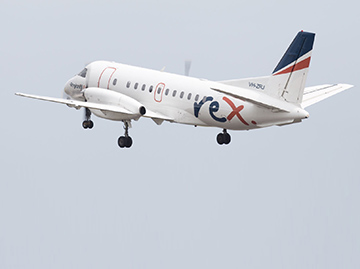- Fatigue may have contributed to the first officer not hearing the captain’s ‘gear up’ call.

On the evening of 4 December 2014, a Saab Aircraft Co. 340B aircraft, registered VH-ZRJ and operated by Regional Express, was on a scheduled passenger service from Sydney to Narrandera, New South Wales. After take-off from runway 34 Left the crew inadvertently did not retract the landing gear. The crew later identified this and instinctively retracted the gear whilst the aircraft was above the maximum landing gear retraction speed.
The ATSB found that at the time of the occurrence the first officer (FO) was experiencing a level of fatigue that affected performance. However, the FO’s ability to self-assess their level of fatigue was impeded by a lack of training and objective tools to determine their suitability to operate.
The ATSB also found that the FO did not recall hearing the captain’s ‘gear up’ call, which meant that the gear was inadvertently not retracted. The factors that influenced this omission and its non‑detection included both crew focusing on departure procedures and the local weather, and the crew likely expecting that the landing gear was retracted as normal.
The crew detected the error when conducting the climb checklist. As this checklist was designed to confirm the configuration of the aircraft, the time that it was conducted coincided with a time when the aircraft’s speed was above the maximum gear retraction speed. Therefore, there was an increased risk that crew would react to the unexpected gear position before slowing the aircraft.
In March 2013, the Civil Aviation Safety Authority released new rules on fatigue management for flight crew. At the time of the occurrence, air operators that already held, or had applied for an air operator’s certificate after April 2013, had until April 2016 to transition to the new fatigue management rules. Consistent with this timeline, Regional Express was planning for their transition to meet those requirements at the time of the occurrence. In November 2015, this deadline was extended by the Civil Aviation Safety Authority to May 2017.
Safety message
This occurrence demonstrates some of the factors that increase the risk of making and not detecting errors of omission, particularly actions prompted by verbal cues. The use of a checklist helps identify errors, but they are most effective in this regard, if they are timed to be conducted before approaching aircraft limits.
Further, while this occurrence highlights the difficulties associated with assessing fatigue, operators and crew share responsibility for managing the risk of fatigue. Operators can reduce fatigue risk by providing crew with adequate rest opportunity, comprehensive training in fatigue management, and tools designed to support objective self-assessment of their alertness. Crew can then use the knowledge and tools to help identify when fatigue is present and may affect safety.
Read the report: Landing gear overspeed involving a Saab 340B, VH-ZRJ, near Sydney Airport, New South Wales, on 4 December 2014


